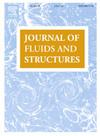使用兼容表面的高提升装置
IF 3.4
2区 工程技术
Q1 ENGINEERING, MECHANICAL
引用次数: 0
摘要
失速延迟和升力增强对现代飞机的性能起着至关重要的作用。这通常是通过位于飞机机翼前缘或后缘的板条或襟翼等装置来实现的。在本文中,我们报告了利用轻质顺应面制造新型高升力装置的可行性研究。我们在风洞中通过力、旗帜变形和流场测量,研究了一端固定或两端固定在机翼前缘和后缘附近的顺应性旗帜的效果。当旗帜靠近前缘时,前缘分离剪切层的激励是增加滞后攻角升力的主要机制。相比之下,两端固定且长度过长的后缘旗可以增加有效外倾,并在时间平均意义上增加机翼周围的环流。这种机制与传统的古尼襟翼效应类似,在失速前和失速后攻角下同样有效。配合使用时,在目前测试的参数范围内,顺应式襟翼可将失速角推迟 8°,并将最大升力系数提高 67%。作为一种被动方法,兼容表面不需要外部动力。如果作为主动方法使用,它们重量轻,易于储存和展开。本文章由计算机程序翻译,如有差异,请以英文原文为准。
High lift devices using compliant surfaces
Stall delay and lift enhancement play a crucial role in modern aircraft performance. This is commonly achieved by devices such as slats or flaps located at the leading edge or trailing edge of an aircraft's wing. In this paper, we report a feasibility study of using light-weight compliant surfaces for novel high lift devices. The effects of compliant flags with one end fixed or both ends fixed near the leading edge and trailing edge of an airfoil were studied by force, flag deformation, and flow field measurements in a wind tunnel. When a flag is placed near the leading edge, the excitation of the separated shear layer from the leading edge is the main mechanism in increasing the lift at the post-stall angles of attack. In contrast, the trailing-edge flag with an excess length and both ends fixed could increase the effective camber and the circulation around the airfoil in a time-averaged sense. The mechanism is similar to that of the conventional Gurney flap effect, and equally effective at pre-stall and post-stall angles of attack. When used together, the compliant flags can delay stall angle by 8° and increase the maximum lift coefficient by 67% in the parameter range tested presently. Compliant surfaces require no external power as a passive method. If they are to be used as active methods, they are light weight, and can be stored and deployed easily.
求助全文
通过发布文献求助,成功后即可免费获取论文全文。
去求助
来源期刊

Journal of Fluids and Structures
工程技术-工程:机械
CiteScore
6.90
自引率
8.30%
发文量
173
审稿时长
65 days
期刊介绍:
The Journal of Fluids and Structures serves as a focal point and a forum for the exchange of ideas, for the many kinds of specialists and practitioners concerned with fluid–structure interactions and the dynamics of systems related thereto, in any field. One of its aims is to foster the cross–fertilization of ideas, methods and techniques in the various disciplines involved.
The journal publishes papers that present original and significant contributions on all aspects of the mechanical interactions between fluids and solids, regardless of scale.
 求助内容:
求助内容: 应助结果提醒方式:
应助结果提醒方式:


